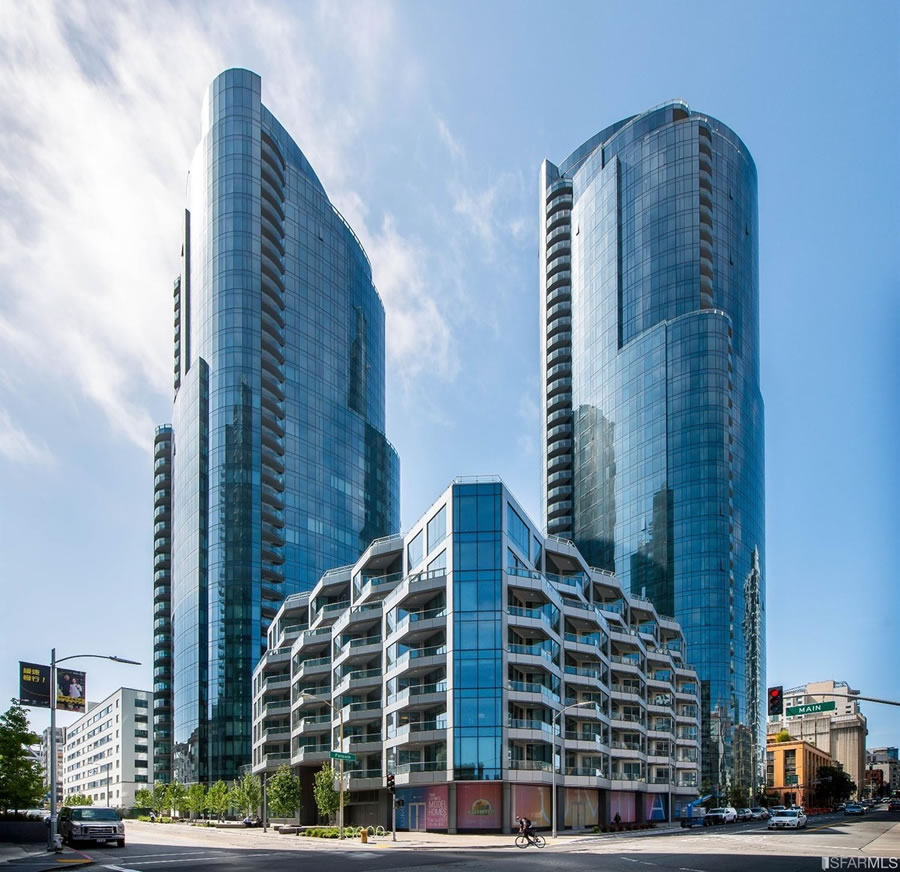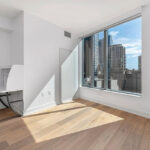Listed for $1.15 million three months ago, the sale of the 851-square-foot, one-bedroom unit #16H on the 16th floor of the Lumina tower at 201 Folsom Street, which features “panoramic views,” wide plank hardwood floors, Siematic cabinetry, Gaggenau & Bosch appliances, custom closets, and a parking space in the building’s garage, has just closed escrow with a contract price of $999,000.
As the unit’s list price was reduced to $1.099 million in late August, to $1.039 million in September and then to $999,300 last month, however, the sale was effectively “at asking” according to all industry stats and aggregate reports.
But as the unit was purchased for $1.2 million July of 2016, according to a review of its deed, its value has dropped 16.75 percent on an apples-to-apples basis while the Case-Shiller index for Bay Area condo values overall is up 14.1 percent over the same period of time. And the “median sale price” is up as well.
A signature two-bedroom on the same floor, unit #16C, traded for 1.3 percent below it 2016 price two years ago.






There is clearly an over supply of this kind of properties in SF. I never saw much potential in these highrises back in 2010, I still dont see any today.
It’s not a sudden increase in supply that’s currently driving the market but rather a shift in the demand curve and a sharp drop in rents, citywide.
Agreed. The “vision” of the TTC as a vibrant Grand Central type location going 24/7 with boutiques, museums and a myriad of restaurants was always a long shot. Covid aside, it depended on HSR and the construction of much additional office space and condos to come to fruition. Already (prior to Covid) the Oceanwide condo tower as well as the Renzi tower had been abandoned. So too the proposed skinny tower on Howard – in its case cosigned to permanent limbo. Plus other close-by projects. Now, the Claw tower itself looks like it won’t be built. Parcel F, which was slated to have the 4th tallest SF tower, looks to have been a white elephant for the developers who paid the City a ridiculous amount for the site. Currently much of the office space – and workers – are absent and the street level retail is mostly closed. That retail was sluggish prior to Covid on weekends when the TTC was basically empty sidewalks and brooding shadows. It’s not likely that major office and residential development will return to the area. The empty office space will eventually be occupied but likely by not as many workers as before – and the same fate could befall the greater SOMA area with DropBox (subleasing a third of its Exchange space with more to come) moving much of its workforce out as well as Pinterest. Not to mention Stripe which announced its departure from SF prior to Covid..
The vision for that neighborhood did not depend on HSR. HSR was years away, but there were already a myriad of restaurants and museums. The neighborhood was growing and healthy.
What will be in store after Covid? No one knows. We haven’t had anything similar in 100 years.
You’re referring to temporary blips on the timeline. The trajectory is very clear.
Fifteen years ago that area was filled with parking lots. Now it’s filled with gleaming towers and plans for many, many more. Sure, some of them missed this cycle. That’s fine. But it’s quite likely that they’ll be built in the next cycle, or the cycle after that.
The trajectory might be very clear, but the problem/challenge with buying in that area is that there is NO fundamental difference between this tower and that tower…and each year, your unit is getting older and less trendy, and harder to compete with the brand new building next door. That is why I never saw any reason to buy in that area. Rent? great, I would absolutely go for that IF I want to live in that area…
What’s the fundamental difference between a two bedroom Victorian on Page St vs on Grove St in the Panhandle? Probably even less than these buildings since views and amenities can vary.
And by the way, those buildings aren’t my cup of tea either.
Not a given. Prior to Covid the macro-trend was a shift of tech jobs out of the BA to sub-tech hubs. population growth was anemic and drifting down. A researcher at the Wharton School believes tech hubs will emerge up and down the West Coast. I believe that trend will not be limited to the West Coast. SV will remain the hub of tech but its absolute dominance in terms of tech jobs and start-ups will decline relative to other regions. Tech within the BA will shift out of SF (think Stripe, Twitter, DropBox) and so SF will become relatively less important as a tech jobs center compared to other BA locales. All this ultimately makes the future of the TTC less promising than once envisioned.
For years, Dave has been (falsely) claiming that San Francisco’s population is shrinking. No one knows what the economy will look like in a year. Not you, not me, not some guy at Wharton. The only precedent for Covid was 100 years ago and the world was very different then.
While the pandemic has certainly accelerated and amplified the trend, keep in mind that net migration into San Francisco, and the Bay Area overall, actually turned negative for the first time in a decade last year, which laid the foundation for the market at hand.
That really *wasn’t* the trend. Prior to Covid, the big tech employers couldn’t find enough space to lease in San Francisco. Nobody knows what office work will be like in 3-5 years but you’re counting San Francisco out way too soon.
I don’t always agree with Dave, but think he is right here. Distributed workforce in tech was talked about by Jack Dorsey and others before covid. Covid was the accelerant.
I also think that there is room for gray area: It’s not either back to “normal” or 100% WFH. Many companies will fall in the middle or have smaller, cheaper tech hubs where they rotate teams in and have partial WFH and obviously many tech jobs remain. It will take a while to settle out. At a different stage of Covid, yes some people will move back to SF. But many high income earners are permanently gone. This is a structural decoupling of tech jobs in the area vs the economic cycle.
What is the driver for immigration to San Francisco? Tech is not it. So what else?
“Tech is not a driver of immigration to San Francisco” is a ridiculous statement. Take a look at the job boards across AngelList, Indeed, LinkedIn, or on the company Careers pages of about hundreds of companies in SF.
Back in 2008, 39 percent of the 571,000 jobs in San Francisco were “office” based, versus 18 percent retail, 15 percent industrial, 3 percent hotel and 25 percent “cultural, institutional or educational.”
From 2008 to 2018, the number of office based jobs in the city increased by 86,000 or 39 percent (versus an 18 percent gain for retail, 19 percent gain for industrial, 26 percent gain for CIE and a 17 percent drop for hotel).
And in 2018, 42 percent of the 725,000 jobs in San Francisco were office based, with 17 percent retail, 14 percent industrial, 2 percent hotel and 25 percent cultural, institutional, educational and other.
Ah…2008…i remember it well: most of the country was excited at the prospect of a new President, while deep in the dark recesses of the country various cretins plotted their revenge (so not much changed, there, I guess). But here, Socketsite was still a wee lad, getting thrown out of data bars when it sidled up for a shot of .csv, w/ a .pdf chaser. 🙂
As for the data presented: not much changed on that either, relatively speaking: mostly industry has shrunk…who’d a thunk it?
Tech employers have been the largest consumers of office space in the market cycle that just ended. Banking and law not so much.
The area isn’t the issue, this unit is absolutely charmless. No den, no nooks, it has the cozy factor of an operating room.
i’d say the main feature that’s lacking from the unit is a deck/balcony, at this price for a 1 bed.
SF is not as desirable as it once was, face it , living in a cliff/ condo dwelling (unless one has has bucks to use it as a weekend get away ) has no comparison to a single family house and one preferably with no homeless nut jobs pitching tents outside your front door. SF has lost great deal its unique nature and it has real problems with a city government that is truly 89%$7 up.